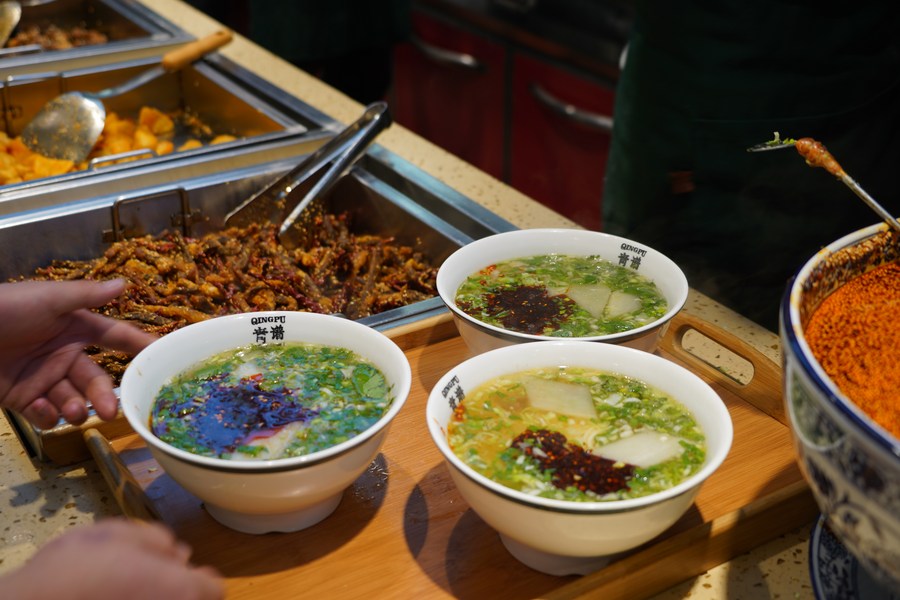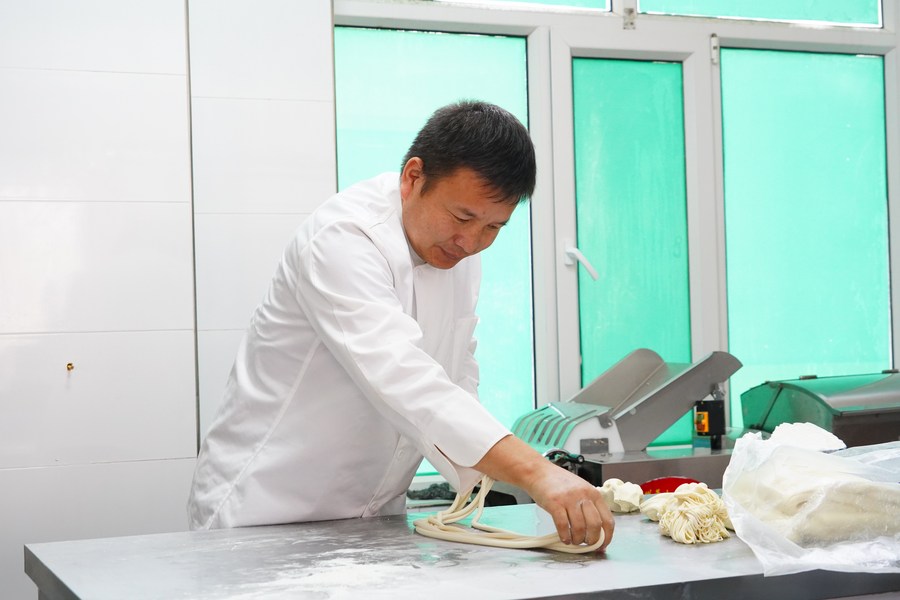Aroma of Chinese Lamian noodles wafts to Belt and Road countries
* In recent years, Lamian noodles have become a calling card and important industry in northwest China, including the provinces of Qinghai and Gansu.
* Currently, there are 166,000 people engaged in the Lamian noodles industry in the city of Haidong, accounting for the majority of Qinghai's total. Those Haidong noodles makers have so far opened 27,700 restaurants in over 280 cities at home and abroad.
* Since the Belt and Road Initiative was proposed, Lanzhou beef Lamian noodles have entered more than 40 countries. The food's major brands have opened over 500 restaurants in Japan, Malaysia, New Zealand and other countries.
Lamian noodles, or hand-pulled noodles, is a traditional Chinese dish. It has a variety of appetizing flavors such as Qinghai Lamian noodles and Lanzhou beef Lamian noodles.
In recent years, Lamian noodles have become a calling card and important industry in northwest China, including the provinces of Qinghai and Gansu.
In Qinghai, there are 199,500 people engaged in the Lamian noodles industry, while more than 35,000 Lanzhou beef Lamian noodles restaurants have been set up in Gansu and many other regions nationwide, creating jobs for over 600,000 people and generating an annual turnover of about 65 billion yuan (about 9.47 billion U.S. dollars).
The successful development of the Lamian noodles industry has helped people blaze a path of poverty alleviation and prosperity. Since the launch of the Belt and Road Initiative, more noodles makers have pursued new business opportunities in Belt and Road countries and regions, sharing this Chinese flavor with more people worldwide.
PATH OF PROSPERITY
Ma Xueming, 41, is from Hualong Hui Autonomous County in the city of Haidong, Qinghai. In 2002, Ma left the poverty-stricken mountainous county and opened a Lamian noodles restaurant in Shanghai.
A stove, a chopping board, several tables and chairs. His 30-square-meter restaurant opened to the public soon after he reached Shanghai, which became the starting point of his business journey.

This photo taken on April 5, 2023 shows three bowls of just-cooked Lamian noodles at a noodle restaurant run by Ma Xueming in Xining, northwest China's Qinghai Province. (Xinhua/Geng Huihuang)
"I had to work for more than 10 hours every day. After a day's work, I couldn't even lift my arms but still had to stick with it. Living a good life was my motivation," Ma recalled his startup experience.
Tasty and authentic Lamian noodles won more and more customers for Ma. By 2005, he had opened three Lamian noodles restaurants in Shanghai, earning a total income of 100,000 yuan in 2005.
Ma's business is expanding. He has set up his own Lamian noodles brand. At present, he has over 60 noodles restaurant outlets nationwide, including franchised ones. The noodles soup he developed has been supplied to more than 2,000 Lamian noodles restaurants across the country.
As is the case for Ma, a bowl of Lamian noodles has changed the lives of many people. In Haidong, dubbed "the hometown of Lamian noodles," 72,600 people had been lifted out of poverty by engaging in the industry as of 2021.
Currently, there are 166,000 people engaged in the Lamian noodles industry in Haidong, accounting for the majority of Qinghai Province's total. Those Haidong noodles makers have so far opened 27,700 restaurants in over 280 cities at home and abroad, and the city's Lamian noodles industry saw an operating income of around 13 billion yuan in 2022.
OVERSEAS EXPANSION
This year marks the 10th anniversary of the Belt and Road Initiative. As cultural and business exchanges further deepen among countries and regions forming part of the Initiative, Chinese Lamian noodles makers are seeking new business opportunities there.
In 2003, Ma Fanglin from Haidong went with her family to Lanzhou, capital of Gansu Province, to run their first Lamian noodles restaurant. Over the next 20 years, they opened more restaurant outlets in the Chinese cities of Xi'an and Changsha, and now her husband runs one in Kuala Lumpur, Malaysia.
"We opened the Lamian noodles restaurant in Kuala Lumpur in 2016 and its size is more than 200 square meters. Its turnover per month is around 200,000 yuan," said Ma. "Local people have a dietary habit similar to ours, while we have also developed innovative dishes to suit the local customs there."
Ye Xiaolong, a 34-year-old native of Haidong, opened a Lamian noodles restaurant in Sihanoukville, Cambodia, in 2019. "A bowl of Lamian noodles only costs 5 U.S. dollars here. It's very popular among locals because of its affordable price and good taste," said Ye, who has three Cambodian employees.
"My uncle is decorating a Lamian noodles restaurant in Bangkok, which will open soon," said Ye. "More and more people can get a taste of this food, which opens a window for them to understand Chinese food culture and China."

Han Yulong processes Lamian noodles at his Lamian noodle restaurant in Haidong, northwest China's Qinghai Province, on Feb. 8, 2023. (Xinhua/Geng Huihuang)
According to Chen Jianhong, director of the Haidong municipal local brand industry cultivation and promotion bureau, by the end of 2022, Haidong's Lamian noodles makers had opened around 40 restaurant outlets in more than 10 countries and regions along the Belt and Road.
FOOD CULTURE SPREADING
Liang Shunjian is very busy these days. Later this month, he will travel with a group of Lamian noodles makers from Lanzhou to Auckland, New Zealand, where a Lanzhou beef Lamian noodles restaurant will open soon.
At this restaurant, visitors can both taste delicious food and learn how to make it, with professional noodles makers guiding them at this dual-purpose venue.
Liang was a Lamian noodles maker years ago. In 2018, the food company he established co-founded the Lanzhou beef Lamian noodles international alliance and the Xinglong Lanzhou beef Lamian noodles international business school to help train professional Lamian noodles makers and spread this Chinese food overseas.
"Our students not only come from China but also from foreign countries. Currently, more than 1,000 Lamian noodles makers we have trained work in overseas Lamian noodles restaurants," said Liang. "They not only make a living from this skill but also serve this Chinese taste to more people."
Since the Belt and Road Initiative was proposed, Lanzhou beef Lamian noodles have entered more than 40 countries. The food's major brands have opened over 500 restaurants in Japan, Malaysia, New Zealand and other countries, said Liang. "Chinese Lamian noodles are going global."
